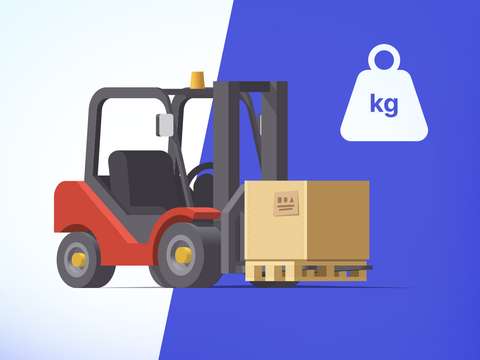If you have a fashion eCommerce, packing and shipping clothes efficiently are important to improve profit margins. To do this, it is not enough to choose the cheapest carrier. You must learn how to manage the order and minimize shipping costs. According to statistics from Statista, these costs can represent up to 90% of the total fulfillment costs... Below, we explain step by step the best way to ship clothes, from packaging to checking the carriers.
Everything you need to know when shipping the clothes you sell online.

How to ship clothes you sell online
Sending clothes is quite similar to sending any other goods. All you need to do is:
- Weigh and measure the clothes
- Contact the shipping company
- Generate shipping documentation
- Invest in automation
Recommend to read
Learn how to professionally manage your eCommerce shipments.
Step 1: Weigh and measure the clothes before shipping
Knowing the weight and measurements of your packages is necessary to calculate the cost of shipping. It will also allow you to select the size of boxes you really need.
A small error in this calculation could cause carriers to offer you higher rates than they really should, increasing your costs.
To make sure you are paying the right amount:
- Check your scale: Before you start, make sure your scale is calibrated and level. This will ensure the accuracy of the weight, avoiding additional charges for measurement errors.
- Write everything down: Carefully weigh each package and note its weight and dimensions.
- If you are sending multi-product shipments, group garments by similar size and weight. This will help you optimize packaging and reduce empty space in boxes.
- Integrating a scale into the packing station will allow for faster and more accurate weighing, optimizing the efficiency of your workflow.
Step 2: Prepare the order
Use a box that fits the size of the clothes, leaving some space so that the garments are not under pressure.
Place the garments compactly inside the box and use tape to prevent carriers from opening the box by mistake during shipment.
Many carriers may refuse your package at the time of collection if they find that the packaging is not optimal for transportation.
Step 3: Contact a carrier
Choose a carrier that has wide coverage in the regions where you want to ship your clothes.
This will allow you to reach your customers regardless of their location, optimizing delivery time and cost.
You should also compare delivery times and shipping methods in order to offer those most in demand by your customers (express, standard, economy, etc.).
Pro Tip
If you ship frequently, look for a carrier that offers volume discounts toreduce shipping costs.
Step 4: Generate shipping documentation
Shipping documentation allows the carrier to deliver orders to the agreed address. Not only do they ensure a smooth delivery, they also allow you to comply with legal and customs requirements...
What documents are required to ship clothing?
- Commercial Invoice: This should include information such as sender and recipient addresses, detailed description of the goods, individual and total values, and shipping costs.
- Packing List: Lists each item shipped with its description, quantity, weight and individual value.
- Waybill: Certifies ownership of goods and facilitates tracking and inventory control.
- Certificate of Origin: May be required for international shipments with tariff benefits.
- Shipping insurance (optional): these documents are provided by the transport companies and allow you to claim compensation in case the shipment suffers an incident
- Shipping label: Must include the recipient's full address, sender's contact information, and any other information required by the carrier.
Step 5: Invest in automation
If you manage a large volume of orders and want to minimize your logistics costs, you'll need to find the best way to ship clothing in bulk.
Specialized eCommerce shipping software imports orders and automatically assigns carriers, eliminating manual handling.
Many of these software solutions (such as Outvio, for example) will also help you print labels and send notifications to the customer to ensure a good delivery experience.
Related article
How to pack clothes for shipping: tips and best practices
Clothes are not fragile materials, so the process is less complicated than in other industries.
Follow these steps the prevent shipping damage, and your clothes will arrive at their destination in perfect condition:
- Fold your clothes well
- Use the right packaging
- Fill any empty spaces
Step 1- Fold the clothes
Efficiently folded, clothing takes up less space, allowing for optimized packaging and storage both in the shipping process and at the final destination.
For example, when shipping shirts, neatly folded shirts can be stacked more easily to form a homogeneous package.
If you own an eCommerce with several employees, we recommend establishing standardized folding procedures for each type of clothing. This will minimize errors and speed up work processes.
Step 2 - Use the right packaging for each shipment
The right packaging ensures that your clothes reach your customer in perfect condition, enhancing their shopping experience and your brand image.
- Polyethylene (plastic) bags: Economical and versatile for small garments (T-shirts, underwear). Transparent for easy inspection and water-resistant.
- Polypropylene (plastic) bags: Stronger and more durable than polyethylene bags. Ideal for garments that need more protection (winter clothing, coats, delicate garments).
- Kraft paper bags: Sustainable and ecological. They convey an image of luxury and care for the environment. Perfect for high-end fashion (dresses, shirts, trousers). Customizable with the brand logo.
- Cardboard boxes: Superior protection against knocks and crushing. Ideal for shipments of several garments or large items (suits, jackets, shoes). Customizable with the brand logo. Recyclable and reusable.
- Tissue or bubble wrap: Protects garments individually inside boxes or bags. Ideal for delicate fabrics or garments with embellishments.
Step 3 - Fill in the gaps
If there are any empty spaces in the package, fill them with cushioning material. This will prevent the clothes from wobbling, getting damaged, or becoming disorganized.
Some tips
- Be sure to evenly distribute the cushioning material throughout the empty space inside the pack.
- Before closing the package, shake it gently to make sure that the products do not move and that the filling material provides sufficient protection.
- Finding the right balance of protection for your shipments is critical. Excessive use of cushioning material can unnecessarily increase the weight and volume of the package.
How much does it cost to ship clothes
The cheapest way to ship clothing within the USA
Carrier pricing may vary depending on the weight of your order, the dimensions, the destination address or the rates you have previously negotiated.
However, we can always take an online rate calculator and analyse the prices of a fictitious shipment. This will give you a rough idea.
Here's how much it costs to ship 2 kg of clothes from New York to Los Angeles.
| Transport service | Delivery time | Pricing |
|---|---|---|
| UPS Next day | 1 day | 90.93$ |
| USPS Priority mail | 1 - 3 days | 16.67$ |
| Fedex 2day | 2 days | 13.47$ |
| Sendle Preferred Drop Off | 1 - 4 days | 10.78$ |
| USPS Ground Advantage | 2 - 5 days | 8.02$ |
The cheapest way to ship clothing is via USPS Ground Advantage.
The cheapest way to ship clothing internationally from the USA
Now let's see how much it costs to ship 2kg of clothes from New York to Paris.
| Transport service | Delivery time | Pricing |
|---|---|---|
| UPS WorldWide Express | 1 day | 58.44$ |
| Flat Export | 4 - 9 days | 50.88$ |
| UPS WorldWide Expedited | 4 days | 13.47$ |
| Orange DS Expedited | 12 - 17 days | 25.45$ |
| FedEx International Plus | 2 - 5 days | 18.16$ |
The cheapest way to ship clothing internationally is via FedEx International Plus.
Who is responsible for paying the duties and taxes?
In general, the end customer is responsible for paying import duties and taxes on clothing purchased online. However, there are some exceptions:
- DDP (Delivery Duty Paid) model: In this model, the seller assumes responsibility for the payment of duties upfront. This means that the final price of the product already includes duties and taxes, offering greater transparency for the customer.
- Specific cases: Some countries or online shops may have different policies regarding who pays duties and taxes. It is important to check the specific conditions of each case before purchasing.
To get a rough idea of the charges that will apply to your shipment, you can use an online taxes calculator. These tools allow you to enter information such as the value of the goods, the country of origin, and the country of destination to get an accurate estimate of duties and taxes.
Strategies to increase the profitability of your shipments
Send order notifications with promotional products
When a customer places an order in your online shop, you can send a shipping notification that includes suggestions for additional products based on the purchased item.
For example, if the customer bought a shirt, you could suggest accessories such as ties or trousers that go well with the selected shirt.
Trabaja con varios transportistas para tener flexibilidad y opciones en función de las necesidades de cada envío y las ubicaciones de entrega.
Work with multiple carriers and compare rates in real time
Working with multiple carriers gives you flexibility and choice for your shipments. Depending on the specific needs of each shipment and delivery location, you can choose the most appropriate carrier for each situation.
For example, if you need fast deliveries in metropolitan areas, you might opt for a local courier service, while for international shipments, you might choose a carrier with experience in international trade.
Pro Tip
A multi-carrier shipping software with allocation rules (such as Outvio) automates the selection of the most cost-effective carrier based on the criteria of your choice
Automate returns and promote in-store credit
The clothing industry is one of the biggest return industries. Items such as skirts can have a 47% return rate. Therefore, if you sell and ship clothing, another aspect to optimize is returns. Implement a streamlined returns process that reduces the workload and resources required by your team. Also, integrate a digital portal that facilitates product exchange to avoid cash refunds.
However, the secret to turning returns into opportunities lies in promoting in-store credit. Offer your customers attractive discounts applicable to their future purchases. This ensures that the cost of the refund ends up in your business, with the additional likelihood that the customer will make higher-value purchases.
FAQ
What is the best way to ship clothing in bulk?
The best way to ship clothing in bulk is typically through freight shipping or using a reputable courier service that offers bulk shipping discounts. If you have a lot of orders, you apply automation techniques to improve your shipping processes.
How to package clothes in bulk for shipping
In addition to using the scale at the packing station, it is important that you use a barcode to verify the goods to be shipped. This step is essential if you process a large number of garment orders, as it eliminates errors during manual processing.
How much to charge for shipping clothes?
The shipping cost for clothes depends on factors like weight, destination, and shipping method. It's best to calculate shipping costs based on these factors and consider offering flat-rate or free shipping options for customer convenience.
Conclusion
Apparel shipping and packaging are critical to your customer satisfaction and financial success. It is crucial that you implement efficient shipping strategies, such as the careful selection of packaging materials, collaboration with reliable carriers, and process automation. Additionally, quality packaging will not only protect your garments during transport but also influence customer perception of your brand's reputation.




